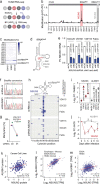Mitochondrial RNA modifications shape metabolic plasticity in metastasis
- PMID: 35768510
- PMCID: PMC9300468
- DOI: 10.1038/s41586-022-04898-5
Mitochondrial RNA modifications shape metabolic plasticity in metastasis
Abstract
Aggressive and metastatic cancers show enhanced metabolic plasticity1, but the precise underlying mechanisms of this remain unclear. Here we show how two NOP2/Sun RNA methyltransferase 3 (NSUN3)-dependent RNA modifications-5-methylcytosine (m5C) and its derivative 5-formylcytosine (f5C) (refs.2-4)-drive the translation of mitochondrial mRNA to power metastasis. Translation of mitochondrially encoded subunits of the oxidative phosphorylation complex depends on the formation of m5C at position 34 in mitochondrial tRNAMet. m5C-deficient human oral cancer cells exhibit increased levels of glycolysis and changes in their mitochondrial function that do not affect cell viability or primary tumour growth in vivo; however, metabolic plasticity is severely impaired as mitochondrial m5C-deficient tumours do not metastasize efficiently. We discovered that CD36-dependent non-dividing, metastasis-initiating tumour cells require mitochondrial m5C to activate invasion and dissemination. Moreover, a mitochondria-driven gene signature in patients with head and neck cancer is predictive for metastasis and disease progression. Finally, we confirm that this metabolic switch that allows the metastasis of tumour cells can be pharmacologically targeted through the inhibition of mitochondrial mRNA translation in vivo. Together, our results reveal that site-specific mitochondrial RNA modifications could be therapeutic targets to combat metastasis.
© 2022. The Author(s).
Conflict of interest statement
S.A.B. is a co-founder and scientific advisor at ONA Therapeutics. J.H. receives commercial funding from CureVac AG and acts as a consultant and advisory board member for Bristol-Myers Squibb and MSD Sharp & Dohme. M.F. receives commercial funding from Merck. The other authors declare no competing interests.
Figures



















Comment in
-
Targeting metabolic rewiring might decrease spread of tumor cells: Mitochondrial tRNA modifications promote cancer metastasis.Signal Transduct Target Ther. 2022 Oct 8;7(1):360. doi: 10.1038/s41392-022-01205-6. Signal Transduct Target Ther. 2022. PMID: 36209139 Free PMC article. No abstract available.
References
-
- Fendt SM, Frezza C, Erez A. Targeting metabolic plasticity and flexibility dynamics for cancer therapy. Cancer Discov. 2020;10:1797–1807. doi: 10.1158/2159-8290.CD-20-0844. - DOI - PMC - PubMed
MeSH terms
Substances
LinkOut - more resources
Full Text Sources
Molecular Biology Databases
Research Materials
Miscellaneous

